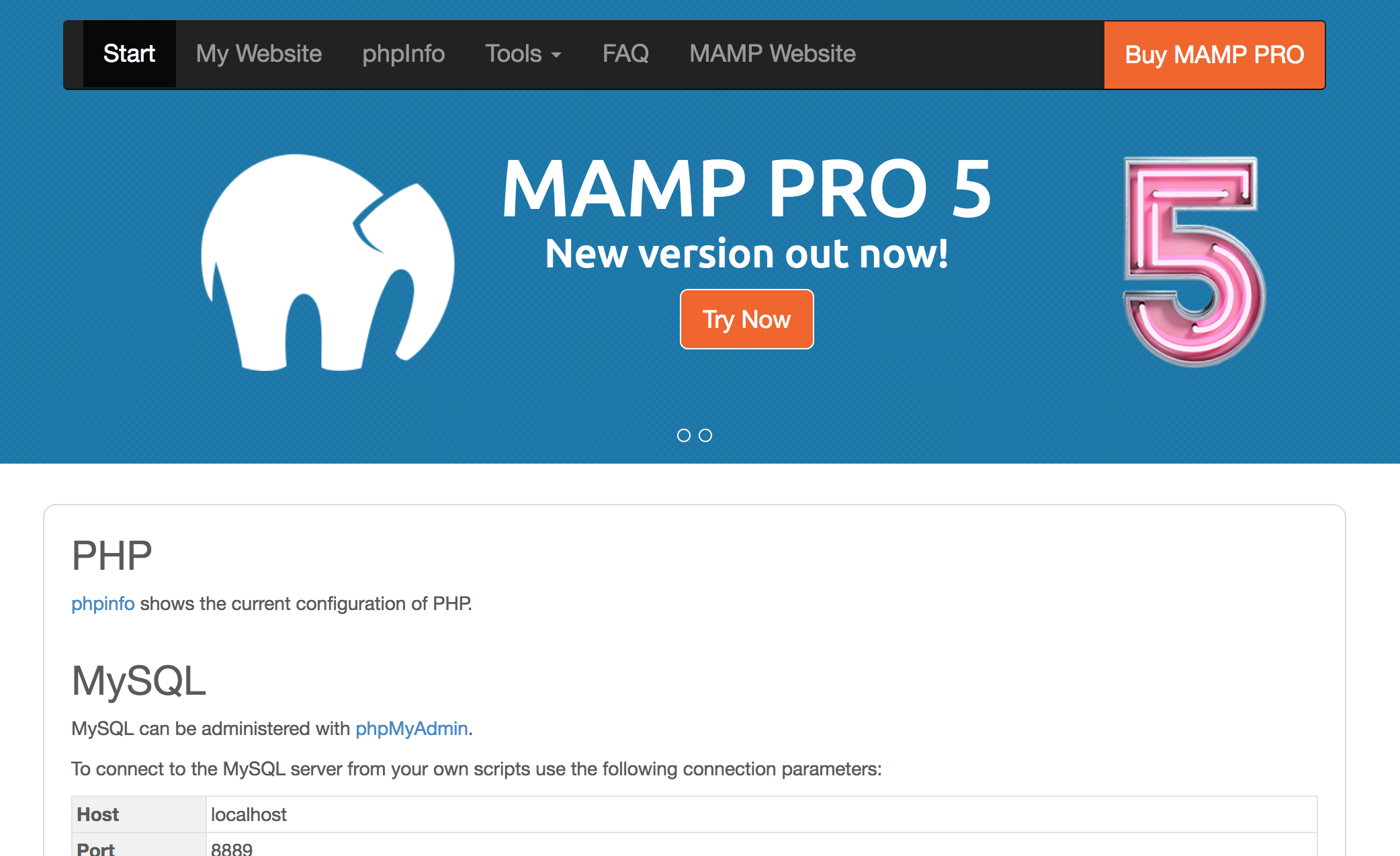

- #MAMP PHPMYADMIN DEFAULT PASSWORD PRO#
- #MAMP PHPMYADMIN DEFAULT PASSWORD SOFTWARE#
- #MAMP PHPMYADMIN DEFAULT PASSWORD TRIAL#
- #MAMP PHPMYADMIN DEFAULT PASSWORD PASSWORD#
- #MAMP PHPMYADMIN DEFAULT PASSWORD MAC#
Basically, try to get the database to show up by wiping MAMP settings clean and copying in database files. But there’s enough to give someone the general idea. Maybe this will be useful for someone else, and if I screwed up something above, it’s because my process wasn’t nearly as linear, so I may have misremembered. That should fix the links and you can change it back to whichever format you prefer again.
#MAMP PHPMYADMIN DEFAULT PASSWORD PASSWORD#
Go to WordPress Admin panel ‘ login with the username and password you had been using all along, then go to:ĭashboard > Settings > s > Check Plain and Save Changes. Go to localhost:8888 in browser and WordPress first page should be back but click here and there and you’ll quickly notice that links are broken. Make sure that WordPress ‘wp-config.php’ file points to a database with the same name. Point to ‘mywebsite.sql’ file you made earlier. Give it a name, (again, I made it slightly different to make the sql file I generated). No databases should be there.Ĭlick New in the database tree on the left.
#MAMP PHPMYADMIN DEFAULT PASSWORD SOFTWARE#
The program gives you local access to an Apache server, which is a web server software that bridges the gap between PHP and web browsers.

#MAMP PHPMYADMIN DEFAULT PASSWORD PRO#
Uninstall MAMP and MAMP Pro by putting folders in Trash again. What is MAMP MAMP is a free, downloadable web development application that can be installed on a macOS or Windows operating system. (I made a slight variation in the name to make it different not sure if that’s important or not.) Save file as ‘mywebsite.sql’ somewhere you can find it. Paste into text editor like Text Wrangler (something that doesn’t muck around with formatting). Select ‘mywebsite’ database and select the Export tab. Go to phpMyAdmin panel, should be up and running now. MAMP Support Forums is an unofficial support forum covering MAMP & MAMP Pro solution stacks. The problem I had here was that all of the database tables were empty and logging into WordPress Admin panel would start a new WordPress installation and that didn’t help. The default password / username for phpMyAdmin in MAMP is root / root. Set WordPress ‘wp-config.php’ file back to MAMP defaults DB_NAME to ‘mywebsite’, username ‘root,’ and password ‘root’. Now, in your backup ‘db’ folder go into ‘mysql’ folder find the folder name of your database (something like ‘mywebsite’ or whatever you named it) and these files:Ĭopy them in the corresponding ‘db > mysql’ folder location and put you contents of “htdocs” back as well. ‘Hard Drive > Applications > MAMP > htdocs’ I’m posting my solution because I hate to leave a thread hanging for the next poor soul in a similar situation.īackup MAMP content folder too if you use the default location:
#MAMP PHPMYADMIN DEFAULT PASSWORD TRIAL#
Everything went to hell after that.Īs for my fix, I’m not saying this is the best way or even a sensible way, this is just how fixed it after a few hours of trial and error (and tears). If you experience is different, please state how, and which versions you're using.I initially borked everything in phpMyAdmin by choosing Privileges tab > Edit Privileges link > Login information link: and I made a unique user name and password and I think selected the radio button “delete the old one from the user tables”. I don't remember where I got that recommendation (this was years ago), but it still seems to be the most correct nowadays. zshrc: a bunch of export lines, mostly for PATH zprofile: emulate sh \ source ~/.profile \ emulate zsh (interesting) bash_profile: source ~/.profile (that's it) It may be valuable for you and others to see the result of cat on different shell config files in my ~:
#MAMP PHPMYADMIN DEFAULT PASSWORD MAC#
My Mac started with Catalina, and has had Big Sur and Monterey previous to now. Considering this article was posted in September of 2019, looks like you were on Mojave.

Maybe you were using something different. As of macOS 10.6 Catalina and its successor Big Sur, Apple has made the zsh shell the default shell, previously it was the bash shell. Please bear in mind that you also have to change the phpMyAdmin configuration and probably your own php scripts to use the newly created MySQL password. zshrc is not where alias should go, it should go into. Enter the following command line: /Applications/MAMP/Library/bin/mysqladmin -u root -p password NewPassword Replace NewPassword with your new password. My MAMP Pro is version 6.8, and my macOS is Ventura 13.2.1.įrom everything I've determined (even going back to Catalina. Apple likes changing file paths all the time for no apparent reason, so some of these just aren't applicable. Would be nice to know which version of MAMP Pro and macOS you wrote the article for.


 0 kommentar(er)
0 kommentar(er)
